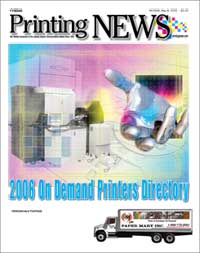|
  May 8, 2006—Advertising Production Club (APC) hosted an event with the United States Postal Service (USPS) on April 19 in New York City. Held at the Morgan Processing and Distribution Center, blocks away from Penn Station, attendees heard from postal employees on the state of mail, and recieved a tour of the facilities to see what snail mail goes through to reach its destination. May 8, 2006—Advertising Production Club (APC) hosted an event with the United States Postal Service (USPS) on April 19 in New York City. Held at the Morgan Processing and Distribution Center, blocks away from Penn Station, attendees heard from postal employees on the state of mail, and recieved a tour of the facilities to see what snail mail goes through to reach its destination.
An average of 13–15 million pieces of mail are processed at this facility daily, most of it staying in the Greater New York area. No one piece of mail stays in the building for more than a day, helped along with a combination of high-tech equipment and old-fashioned manpower.
The event revealed that the USPS has a sales staff out there calling on some of your best clients, selling direct mail and other types of materials. Along with the print industry, they are doing research to support the need for printed, mailed pieces, and are offering alternatives to the plain postcard. Examples of items they have sold are a frisbee with print on the underside, as well as a variety of stiff plastic items in a wide range of shapes, colors, and sizes.
David Mastervich, new business development specialist for the USPS, cited that 48 percent of Americans read the mail to unwind; 42 percent look to the mail for financial savings; 38 percent use the mail to stay informed on key issues; and 64 percent have ordered products or services from mail recieved in the last month.
These statistics are important because they demonstrate that mail, and by necessity print, are far from dead. People may be changing how they consume media, but they have not abandoned the printed mailer yet.
“Not too long ago, we commissioned InnoMedia to research and measure how consumers feel about the mail that shows up in their boxes every day,” said Mr. Mastervich. “What we learned is that despite interest in other forms of communication and diversion to electronic means, mail engages and excites people. It helps build strong and lasting relationships. People expect it every day. Mail is inviting, not intrusive. When it arrives in your mailbox or on your desk and you pick it up and look at it, you’re having a ‘mail moment.’ Our research revealed that 98 percent of consumers...bring in their mail the day it’s delivered, so we think ‘mail moment’ is a phrase that fits.”
Moreover, it is not just the older generations who take note of mailed pieces. “Generations X/Y (ages 29–38/11–28) get and respond well to mail, too. In spite of the electronic media, this younger generation, like their parents, relies on mail. Our research shows that 75 percent of young consumers rate the mail they receive as valuable,” noted Mr. Mastervich. “Even though they are comfortable searching for products online, they say they keep catalogs for an extended period of time and browse through them repeatedly.”
The Walkabout
After the presentation, attendees were taken on a tour of the facilities. The sheer volume of mail moving through the facilities and what it takes to process it efficiently became evident quickly. Around every corner staff and technology were working together to ensure mail made it to its final destination safely and swiftly. One stop along the way even showed a system that can identify a destination when an address is either obscured or illegible.
An image is taken of every mail piece that moves through the faclities—if the address is unreadable that image is sent automatically to a database at the USPS headquarters where a computer system matches it to a location, then sends that information back to the processing facility in a matter of minutes. From there, the piece is automatically pulled and a barcode with the destination information is printed onto the mail, which is then sent back into the cycle. Every piece of mail is given an individual number in addition to having its picture taken, and no two pieces will ever have the same number in our lifetime, or that of several generations to come.
The event was a fascinating look into the other side of direct mail. As printers and graphic communications specialists, it is easy to forget that after you are done with a piece, that is not the end of its journey. It still has a long way to go before it can reach the hands and eyes of the target audience, helped along by a small army of postal employees.
|


